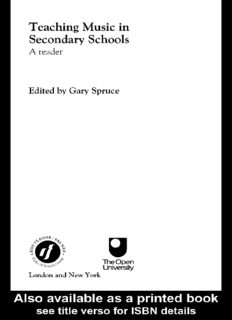Table Of ContentTeaching Music
in Secondary Schools
The Open University Flexible
Postgraduate Certificate of Education
The readers and the companion volumes in theflexiblePGCE series are:
Aspects of Teaching and Learning in Secondary Schools: Perspectives on practice
Teaching, Learning and the Curriculum in Secondary Schools:A reader
Aspects of Teaching Secondary Mathematics: Perspectives on practice
Teaching Mathematics in Secondary Schools: A reader
Aspects of Teaching Secondary Science: Perspectives on practice
Teaching Science inSecondary Schools: A reader
Aspects of Teaching Secondary Modern Foreign Languages: Perspectives on practice
Teaching Modern Foreign Languages in Secondary Schools: A reader
Aspects of Teaching Secondary Geography:Perspectives on practice
Teaching Geography inSecondary Schools: A reader
Aspects of Teaching Secondary Design and Technology: Perspectives on practice
Teaching Design and Technology in Secondary Schools: A reader
Aspects of Teaching Secondary Music: Perspectives on practice
Teaching Music in Secondary Schools: A reader
All of these subjects are part of the Open University’s initial teacher education
course,theflexiblePGCE,andconstitutepartofanintegratedcoursedesignedto
developcriticalunderstanding.Thesetbooks,reflectingawiderangeofperspec-
tives,anddiscussingthecomplexissuesthatsurroundteachingandlearninginthe
twenty-first century, will appeal to both beginning and experienced teachers, to
mentors, tutors, advisers and other teacher educators.
IfyouwouldliketoreceiveaflexiblePGCEprospectuspleasewritetotheCourse
Reservations Centre at The Call Centre, The Open University, Milton Keynes
MK7 6ZS. Other information about programmes of professional development in
education is available from the same address.
Teaching Music in Secondary Schools
A reader
Teaching Music in Secondary Schools: A reader introduces and explores a broad
rangeofcontemporaryissuesandkeyideasandwillprovideausefulbackground
for those teaching and training to teach this exciting subject.
The book is concerned with the bigger picture of music education. Divided into
three sections to help structure reading, it covers:
• Using music technology
• Progression and continuity
• Involving world musics in the curriculum
• The development of children’s musical imagination
• Music psychology
• Valuing children’s efforts in composing
• The history of music education
• Different approaches to music education in other European countries
TheTeachinginSecondarySchoolsseriesbringstogethercollectionsofarticlesby
highlyexperiencededucatorsthatfocusontheissuessurroundingtheteachingof
NationalCurriculumsubjects.Theyareinvaluableresourcesforthosestudyingto
becometeachers,andfornewlyqualifiedteachersandmoreexperiencedpracti-
tioners,particularlythosementoringstudentsandNQTs.Thecompanionvolume
to this book isAspects of Teaching Secondary Music: Perspectives on practice.
GarySpruceisaLecturerinEducationattheOpenUniversityandhasresponsi-
bility for the Open UniversityflexiblePGCE, Music course.
Set book for the Open UniversityflexiblePGCE, Music course EXN880.
Teaching Music in
Secondary Schools
A reader
Edited by Gary Spruce
L E DGE/F
T A
U L
M
O
E
R R
Taylor&Francis Group
London and New York
First published 2002
by RoutledgeFalmer
11 New Fetter Lane, London EC4P 4EE
Simultaneously published in the USA and Canada
by RoutledgeFalmer
29 West 35th Street, New York, NY 10001
This edition published in the Taylor & Francis e-Library, 2005.
“To purchase your own copy of this or any of Taylor & Francis or Routledge’s
collection of thousands of eBooks please go to www.eBookstore.tandf.co.uk.”
RoutledgeFalmer is an imprint of the Taylor & Francis Group
© 2002 Compilation, original and editorial matter,
The Open University
All rights reserved. No part of this book may be reprinted or reproduced or
utilised in any form or by any electronic, mechanical, or other means, now
known or hereafter invented, including photocopying and recording, or in
any information storage or retrieval system, without permission in writing
from the publishers.
British Library Cataloguing in Publication Data
A catalogue record for this book is available from the British Library
Library of Congress Cataloging in Publication Data
A catalog record has been requested
ISBN 0-203-99647-X Master e-book ISBN
ISBN 0–415–26233–X (hbk)
ISBN 0–415–26234–8 (pbk)
Contents
CCoonntteennttss
List of illustrations ix
List of abbreviations x
Sources xi
Foreword xiii
Introduction xv
SECTION 1
What is music and music education? 1
1 Ways of thinking about music: political dimensions and
educational consequences 3
GARYSPRUCE
2 Finding the future in the past: historical perspectives on
music education 25
STEPHANIEE.PITTS
3 Research in the sociology of music education: some
introductory concepts 36
LUCYGREEN
SECTION 2
Music learning and musical development 49
4 Music education: a European perspective 51
JANETHOSKYNS
5 Music psychology and the secondary music teacher 63
ALEXANDRALAMONT
6 Musical development in the primary years 80
JANETMILLS
viii Contents
7 Planning for transfer and transition in music education 92
HELENCOLL
8 Music with emotionally disturbed children 106
YVONNEPACKER
9 Assessment in the arts: issues of objectivity 117
GARYSPRUCE
10 In search of a child’s musical imagination 130
ROBERTWALKER
SECTION 3
Musical contexts 141
11 ICT and the music curriculum 143
PAULWRIGHT
12 The place of composing in the music curriculum 166
TEDBUNTING
13 Relevance and transformation: roles for world musics 181
MALCOLMFLOYD
14 Instrumental teaching as music teaching 193
KEITHSWANWICK
15 The art of improvisation and the aesthetics of imperfection 209
ANDYHAMILTON
Index 227
Illustrations
Figures
3.1 Two types of musical meaning 41
5.1 Bamberger’s typology of rhythm drawings 67
6.1 The Swanwick/Tillman model of musical development 85
13.1 Model of Masai song repertoires 184
13.2 Model of culture 185
13.3 A model of enculturation 186
14.1 Control of loudness on string instuments 198
14.2 Control of loudness on string instuments: high and low starts 199
14.3 Useoftimeininstrumentallessons:fourteachersobservedfourtimes 200
14.4 Group and individual teaching focus of attention 202
14.5 A pedagogical model of instrument learning 206
Table
11.1 Planning schemes of work 157
Description:Teaching Music in Secondary Schools is the accompaniment to its practical-based counterpart Aspects of Teaching Secondary Music. Together they form a comprehensive resource for those engaged with Initial Teacher Training and Continuing Professional Development in Music. Through this reader, student

